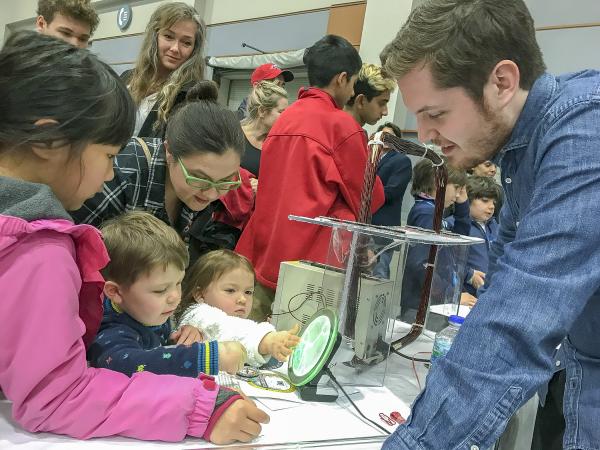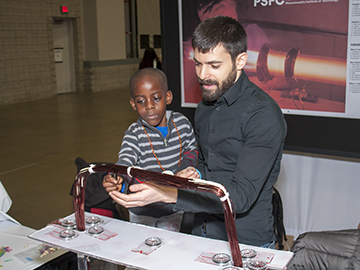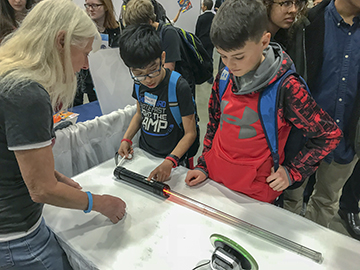
Graduate student Lucio Milanese (right) encourages a family to experiment with a plasma disc at the USA Science and Engineering Festival.
Paul Rivenberg
PSFC education team draws crowds at the USA Science and Engineering Festival
April 17, 2018
In Washington DC scientific curiosity was at its peak, along with the cherry blossoms, during the fifth biennial USA Science and Engineering Festival. Thousands of the approximately 370,000 attendees stopped by the MIT Plasma Science and Fusion Center (PSFC) booth from April 6 – 8 to learn about plasmas and magnets, which are key to the Center’s pursuit of fusion energy. Tending the table of hands-on demonstrations were research scientist Ted Golfinopoulos, graduate student Lucio Milanese, Nuclear Science and Engineering administrator Valerie Censabella and outreach coordinator Paul Rivenberg.
Milanese invited those gathering around the booth to hypothesize about the speeds at which magnets would slide down inclines of plastic, aluminum or copper. The ensuing experiment, a magnet race, revealed that different materials create varying degrees of resistance in a moving magnet.
Golfinopoulos took the lesson further, demonstrating a hand-wound electromagnet, the sides of its open square surrounded by compasses. “Keep your eye on the compass needle,” he commanded, as a volunteer turned on the power. With needles now pointing in new directions, Golfinopoulos was able to demonstrate the way current was running through the electromagnet. Noting that he works at the MIT Plasma Science and Fusion Center, “and none of those words is Magnet,” he explained how important magnets are for controlling the hot plasma fuel of fusion power, which could be the key to economical, clean, sustainable, plentiful energy.


Ted Golfinopoulos (left photo) demonstrates electromagnetism, while Valerie Censabella (right photo) invites students to create a plasma.
Attendees had a chance to make their own plasma by completing a circuit with their finger and energizing a neon plasma in a sword-shaped demo.
“Everyone wants to believe it’s a lightsaber,” says Censabella. “But the plasma sword is actually a great way to introduce people to a fourth state of matter. You can use it as a starting point to discuss all our research at the PSFC, and tailor the explanation to any age. ”
The demos attracted 3-year olds, as well as long-retired scientists.
Milanese, new to the outreach experience, was impressed with the magnitude of the event, and by the enthusiasm that many young people were showing.
“I was very happy to know that several from the groups I spoke to had already heard about fusion and its potential to solve the world’s energy problems. And some had also heard about the SPARC project.”
The recently publicized MIT project will create powerful, compact high-field magnets for a fusion device using new, thin superconducting tape, a sample of which the PSFC team had on hand to pass around.
Milanese believes the interest and familiarity with fusion reflects in part the outreach efforts of the international fusion community. “It underlines the importance of engaging with the public as much as possible. Indeed, our key message on fusion resonated very well with whoever came to talk to us.”
Milanese was receiving emails from some of the students he spoke with even before the festival was over. One parent attending the event has already scheduled a tour of the PSFC for his children and their friends.
“Twenty hours of outreach over three days is exhausting,” admits Censabella. “I was losing my voice. But it was great to see this enthusiasm for science from everyone. It energizes you.”
PSFC education program activities are sponsored in part by the U.S. Department of Energy, Office of Fusion Energy Science.
Topics: Magnetic fusion energy, Plasma science, High field magnets